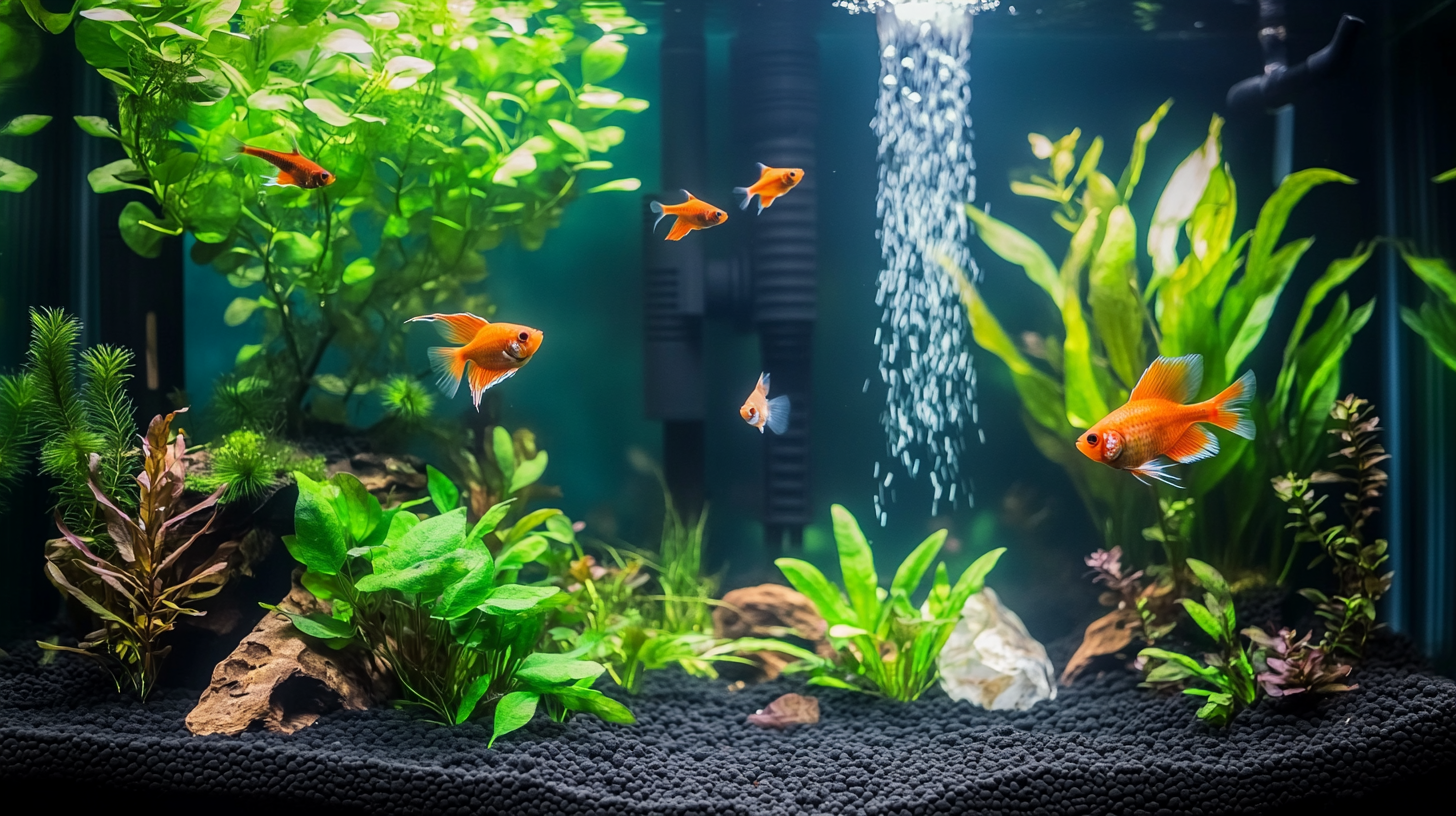Global Market Outlook for Best Fish Tank Filter 2025 Trends and Insights You Need to Know
As the global aquarium market continues to thrive, the demand for high-quality fish tank filters is witnessing remarkable growth. According to industry reports, the global aquarium filter market is expected to reach USD 2.3 billion by 2025, growing at a CAGR of 7.5%. This surge is driven by increasing pet ownership and a rising interest in aquascaping, where aesthetic aquatic environments are meticulously crafted. Notably, Chinese manufacturers are gaining respect worldwide, focusing on quality innovations that meet diverse consumer needs. This blog delves into the latest trends and insights concerning fish tank filters, examining how advancements in technology and sustainable practices are shaping the marketplace. By understanding these dynamics, enthusiasts and retailers alike can make informed decisions in their fishkeeping journeys.

Market Analysis: Current Size and Future Growth of the Fish Tank Filter Industry by 2025
The fish tank filter industry is experiencing significant growth, driven by an increasing interest in home aquariums and sustainable fishkeeping practices. Currently valued at a substantial figure, the market is projected to expand as new technologies enhance filter efficiency and ease of use. By 2025, innovations such as multi-stage filtration systems and smart technology integration are expected to redefine consumer preferences, offering not just effective water purification but also convenience and energy savings.
For aquarium enthusiasts looking to select the best filters, here are some tips: first, consider the size of your tank to determine the necessary flow rate; a filter that is too weak will struggle to maintain water clarity. Additionally, look for models that offer easy maintenance options, as regular cleaning is essential for optimum performance. Lastly, invest in filters that employ advanced filtration media, as these will not only remove debris but also provide biological filtration, promoting a healthy environment for your fish.
As the fish tank filter market evolves, consumers will have access to more sophisticated options. Understanding these trends and making informed choices will be crucial for anyone looking to enhance their aquarium setup. Keep an eye out for eco-friendly alternatives that reduce environmental impact while maintaining optimal tank conditions.
Global Market Outlook for Fish Tank Filters (2025)
The chart above illustrates the projected growth of the global fish tank filter market from 2021 to 2025. It shows a consistent increase in market size, indicating a positive trend for the industry as more consumers invest in aquatic hobbies.
Key Trends Shaping Fish Tank Filters: Innovations and Technologies to Watch
In recent years, the fish tank filter market has seen a wave of innovations driven by technological advancements and the increasing popularity of aquaristics. According to a recent report from Global Market Insights, the fish tank filter market is projected to surpass $1.1 billion by 2025, with a compound annual growth rate (CAGR) of over 7%. This growth reflects a shift towards more efficient and user-friendly filtration systems that cater to both novice aquarium enthusiasts and experienced hobbyists.
One of the key trends shaping the future of fish tank filters is the integration of smart technology. Manufacturers are increasingly offering filtration systems that can be controlled via smartphone applications, allowing users to monitor water quality and filter performance in real time. Additionally, advancements in bioreactor technology are enhancing the ability of filters to maintain optimal water conditions, reducing the need for frequent maintenance. A recent survey conducted by Market Research Future revealed that nearly 62% of aquarium owners prioritize filters with advanced purification technologies, underscoring the demand for high-efficiency systems that promote a healthier aquatic environment.
Moreover, the push towards eco-friendly solutions is also gaining traction in the fish tank filter segment. Environmentally friendly filters that utilize sustainable materials and low energy consumption are becoming more popular among consumers. According to a report by Research and Markets, this trend is expected to contribute significantly to market growth, as awareness of environmental issues continues to rise in the aquarium hobbyist community. As these trends develop, they will undoubtedly shape the future landscape of fish tank filtration systems, making them more effective and sustainable than ever before.

Consumer Preferences: Insights on Demands for Different Types of Fish Tank Filters
As the aquarium industry progresses towards 2025, understanding consumer preferences is crucial for manufacturers and retailers alike. Recent trends demonstrate that consumers are increasingly leaning towards more efficient and eco-friendly fish tank filters. The growing awareness of environmental sustainability has influenced buyers to prioritize products that contribute to a healthier aquatic ecosystem. This shift not only reflects a demand for better filtration technology but also aligns with the rising popularity of aquaculture as consumers become more invested in the health and wellbeing of their aquatic pets.
Tips for identifying the right fish tank filter include evaluating the specific needs of your aquarium. For larger tanks, consider high-capacity filters that can handle increased waste levels, while smaller tanks may benefit from compact, multi-stage filters for effective water quality maintenance. Additionally, check for filters that include features such as bio-filtration or ultraviolet sterilization to ensure a holistic approach to water treatment.
Furthermore, staying informed about market trends can help consumers make smart decisions. The aquarium and fish bowls market is projected to grow steadily in the coming years, driven by an estimated compound annual growth rate of 4.9% from 2025 to 2035. This growth indicates an expanding array of choices for fish tank filters, allowing consumers to select products that best fit their aquariums and personal preferences.
Regulatory Impact: How Environmental Policies are Influencing the Fish Filter Market
 The fish tank filter market is witnessing significant shifts due to the increasing influence of environmental policies. Governments around the world are implementing stricter regulations aimed at promoting sustainability and reducing pollution. These policies are not only limiting harmful materials in manufacturing but also encouraging the use of eco-friendly filters. As a result, companies in the fish filter industry are innovating their products, leading to a rise in demand for filters made from biodegradable or recyclable materials.
The fish tank filter market is witnessing significant shifts due to the increasing influence of environmental policies. Governments around the world are implementing stricter regulations aimed at promoting sustainability and reducing pollution. These policies are not only limiting harmful materials in manufacturing but also encouraging the use of eco-friendly filters. As a result, companies in the fish filter industry are innovating their products, leading to a rise in demand for filters made from biodegradable or recyclable materials.
Moreover, the awareness of water quality and its impact on aquatic life is growing among consumers. Environmental regulations are pushing for advancements in filter technologies, which emphasize enhanced ecological performance. Features like energy efficiency, low water consumption, and improved filtration capabilities are becoming essential selling points. Consequently, businesses that align their products with these regulatory trends are likely to gain a competitive edge in the market, catering to environmentally-conscious consumers who prioritize sustainable practices in their aquatic hobby.
Competitive Landscape: Major Players and Their Strategies in the Fish Tank Filter Sector
In the rapidly evolving fish tank filter market, several key players stand out, each employing distinct strategies to gain a competitive edge. Major brands like AquaClear, Fluval, and Marineland are focusing on innovative product development, introducing advanced filtration technologies that enhance water quality while being user-friendly. These companies are investing heavily in research and development to create filters that not only provide effective mechanical, biological, and chemical filtration but also cater to specific customer needs, such as energy efficiency and quiet operation.
Moreover, partnerships and collaborations are becoming increasingly common among major players. Companies are joining forces with aquarium hobbyist influencers and environmental organizations to promote sustainable practices in filtration technologies. This approach not only bolsters brand image but also taps into the growing consumer demand for eco-friendly products. As the market continues to expand, these strategies will likely redefine the competitive landscape, positioning brands that prioritize innovation and environmental responsibility as leaders in the fish tank filter sector.
Global Market Outlook for Best Fish Tank Filter 2025 Trends and Insights
| Market Segment | Estimated Market Size (2025) | Growth Rate (2021-2025) | Key Trends | Major Strategies of Players |
|---|---|---|---|---|
| Canister Filters | $250 Million | 6.5% | Increased demand for advanced filtration technologies | Focus on product innovation and customer-centric solutions |
| HOB Filters | $180 Million | 5.0% | Rising popularity among beginner aquarium hobbyists | Expansion into emerging markets and sustainability initiatives |
| Submersible Filters | $130 Million | 4.8% | Growing interest in compact and efficient solutions | Strategic partnerships and enhancing online presence |
| Sponge Filters | $80 Million | 3.5% | Increasing use among aquaculture and breeding applications | Investing in R&D and targeting niche markets |
Copyright © 2021 Payless Pet Products - All Rights Reserved.